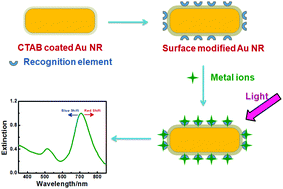A gold nanorod-based localized surface plasmon resonance platform for the detection of environmentally toxic metal ions
Abstract
Gold nanorods (Au NRs) are elongated nanoparticles with unique optical properties which depend on their shape anisometry. The Au NR-based longitudinal localized surface plasmon resonance (longitudinal LSPR) band is very sensitive to the surrounding local environment and upon the addition of target analytes, the interaction between the analytes and the surface of the Au NRs leads to a change in the longitudinal LSPR band. This makes it possible to devise Au NR probes with application potential to the detection of toxic metal ions with an improved limit of detection, response time, and selectivity for the fabrication of sensing devices. The effective surface modification of Au NRs helps in improving their selectivity and sensitivity toward the detection of toxic metal ions. In this review, we discuss different methods for the preparation of surface modified Au NRs for the detection of toxic metal ions based on the LSPR band of the Au NRs and the types of interactions between the surface of Au NRs and metal ions. We summarize the work that has been done on Au NR-based longitudinal LSPR detection of environmentally toxic metal ions, sensing mechanisms, and the current progress in various modified Au NR-based longitudinal LSPR sensors for toxic metal ions. Finally, we discuss the applications of Au NR-based longitudinal LSPR sensors to real sample analysis and some of the future challenges facing longitudinal LSPR-based sensors for the detection of toxic metal ions toward commercial devices.



 Please wait while we load your content...
Please wait while we load your content...